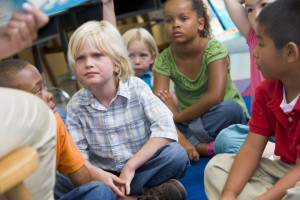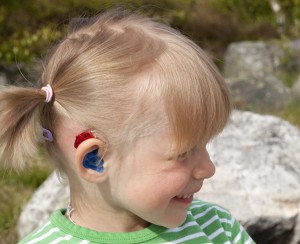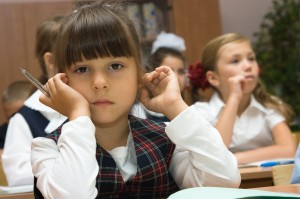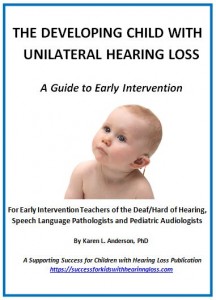Unilateral Hearing Loss
Hearing Loss in Only One Ear
We just found out that our child has a permanent hearing loss, but it’s only in one ear. This doesn’t seem like a big deal. What should we know?
Why it’s a big deal:
One ear cannot listen the same as two ears in all situations. Two ears working together are needed to figure out where sound is coming from. Two ears help us hear better in noisier places. Also, two ears listening together hear just a bit better than one ear working alone. It is very important for learning both at home and at school for a child to hear as well as possible with both of their ears!
Listening Challenges
Children are like little sponges and learn language by hearing it from the people who are around them every day. Any time when listening is not easy it will be harder for a child with unilateral hearing loss to pick up new words. One of the biggest challenges for people with hearing loss in one ear is listening in noisy situations. Having the TV on a lot is just noise to a baby and it can make it really hard for your child to pick up new words from you. Hearing from a distance is also a challenge. Your child can hear you best if you are within a few feet of your child when you talk to him. Because of these listening challenges, children with hearing loss in one ear often need help to clearly hear what you say, as well as what teachers say in school, and what their friends say during play. Without this help, children with unilateral hearing loss may be 10 times more likely to fail a grade in school or need special help to keep up in school. 1/3 to 1/2 of children with hearing loss who have not received help to hear better have problems learning in school! Also, because most rules of social interaction are learned via subtle auditory cues and visual cues, rather than direct teaching, it isn’t a surprise that about 1/5 of these children will develop behavior or social issues.
listening is not easy it will be harder for a child with unilateral hearing loss to pick up new words. One of the biggest challenges for people with hearing loss in one ear is listening in noisy situations. Having the TV on a lot is just noise to a baby and it can make it really hard for your child to pick up new words from you. Hearing from a distance is also a challenge. Your child can hear you best if you are within a few feet of your child when you talk to him. Because of these listening challenges, children with hearing loss in one ear often need help to clearly hear what you say, as well as what teachers say in school, and what their friends say during play. Without this help, children with unilateral hearing loss may be 10 times more likely to fail a grade in school or need special help to keep up in school. 1/3 to 1/2 of children with hearing loss who have not received help to hear better have problems learning in school! Also, because most rules of social interaction are learned via subtle auditory cues and visual cues, rather than direct teaching, it isn’t a surprise that about 1/5 of these children will develop behavior or social issues.
Learning Challenges
Learning issues are largely due to missing incidental speech that occurs in the environment. Even though a child hears typically in one ear, whenever there is noise or the speaker is at a distance the child will miss part of what is said. It is recommended that  children with some usable hearing in their worse ear begin to wear a hearing aid in their poor ear starting in infancy. This will provide more ‘balanced’ hearing and allow the child to pick up incidental language around them, thereby preventing some/all of the possible language delays and behavior/social issues. Waiting to amplify the poorer hearing ear until school age (child is in kindergarten or older) may be too late as their brain will take considerable time to learn how to use the information to localize sound and listen in noise. Until that happens, the child may report that the hearing aid actually makes it more difficult due to amplification of all noise along with speech. Don’t wait! Learning challenges include difficulty learning sound/letter associations in typically noisy kindergarten and grade 1 settings, feeling ‘out of step’ due to missing parts of directions and the inability to hear/understand what peers are saying in the classroom unless they are close and it is relatively quiet.
children with some usable hearing in their worse ear begin to wear a hearing aid in their poor ear starting in infancy. This will provide more ‘balanced’ hearing and allow the child to pick up incidental language around them, thereby preventing some/all of the possible language delays and behavior/social issues. Waiting to amplify the poorer hearing ear until school age (child is in kindergarten or older) may be too late as their brain will take considerable time to learn how to use the information to localize sound and listen in noise. Until that happens, the child may report that the hearing aid actually makes it more difficult due to amplification of all noise along with speech. Don’t wait! Learning challenges include difficulty learning sound/letter associations in typically noisy kindergarten and grade 1 settings, feeling ‘out of step’ due to missing parts of directions and the inability to hear/understand what peers are saying in the classroom unless they are close and it is relatively quiet.
Hearing Loss in One Ear– This information briefly reviews why parents of young children should be concerned about unilateral hearing loss, what they should watch for, and what they should do.
Possible effect on learning: Relationship of Hearing Loss to Listening and Learning Needs – Unilateral Hearing Loss – This single-page handout can be used to assist in planning a young child’s transition to school. It can also be used to inform teachers, other school staff, and medical providers on the potential effects of unilateral hearing loss on learning.
Article: Minimal Hearing Loss: From a Failure-Based Approach to Evidence-Based Practice
Accommodations in the Classroom for the Student with Unilateral Hearing Loss
- Teacher inservice is important. Provide teacher with Relationship of Hearing Loss to Listening and Learning Needs – Unilateral Hearing Loss. It is also helpful to ask the teacher to wear one noise protection ear plug (purchase at drug stores or hardware stores) and demonstrate listening from various parts of the classroom, with and without noise, with back turned and from different seats in the classroom.
 Seating in the rightmost (for good left ear) or leftmost (for good right ear) row is suggested so student’s better hearing ear will almost always face the teacher.
Seating in the rightmost (for good left ear) or leftmost (for good right ear) row is suggested so student’s better hearing ear will almost always face the teacher.- Allow child to change seat locations to direct the normal hearing ear toward the primary speaker and to close the classroom door if he/she is bothered by hall noise.
- Student should be encouraged to turn in his or her seat to face a classmate who is speaking. Teacher should summarize key points spoken by classmates so that this information is accessible to the student.
- Use of a personal FM system to enhance reception of the teacher’s voice is usually warranted. The FM is typically placed in the student’s better hearing ear. An alternative that is less effective is placement in a classroom with a sound field amplification system (amplifies what the teacher says for the whole class). Pre/post testing with the Listening Inventory For Education will assist in verifying the student’s benefit of assistive amplification.
- Educational monitoring is warranted. Teacher completion of the Screening Instrument For Targeting Educational Risk in October (January) and May will allow the student’s function in the classroom in comparison to peers to be easily monitored.
- If using a hearing aid and/or personal FM, the student should be involved in regular amplification monitoring and should receive instruction in how to become his/her own ‘Technology Specialist’.
- Student will benefit from being in contact with other students who have typical hearing in only one ear as a source of mutual support. Facilitated contact through chat rooms, Skype, penpal, or face-to-face formats is strongly suggested so that the student does not feel as isolated and can benefit from brainstorming listening and social issues faced due to unilateral hearing loss.
- Teacher should be aware of the potential impact of unilateral hearing loss on socialization and behavior and provide support when natural opportunities occur to help the student to fit in and be seen as a valuable group member.

“I wanted to thank you for all of the work you do with Supporting Success for Children with Hearing Loss, especially for the publications on unilateral hearing loss (UHL). My six month old daughter has UHL on the left side, with moderate loss at the low and middle frequencies and profound loss at high frequencies. She was fitted for a hearing aid at the end of December and seems to be doing well. We’re still working on getting a hearing specialist through Early Intervention and hope to have that happen soon.”
